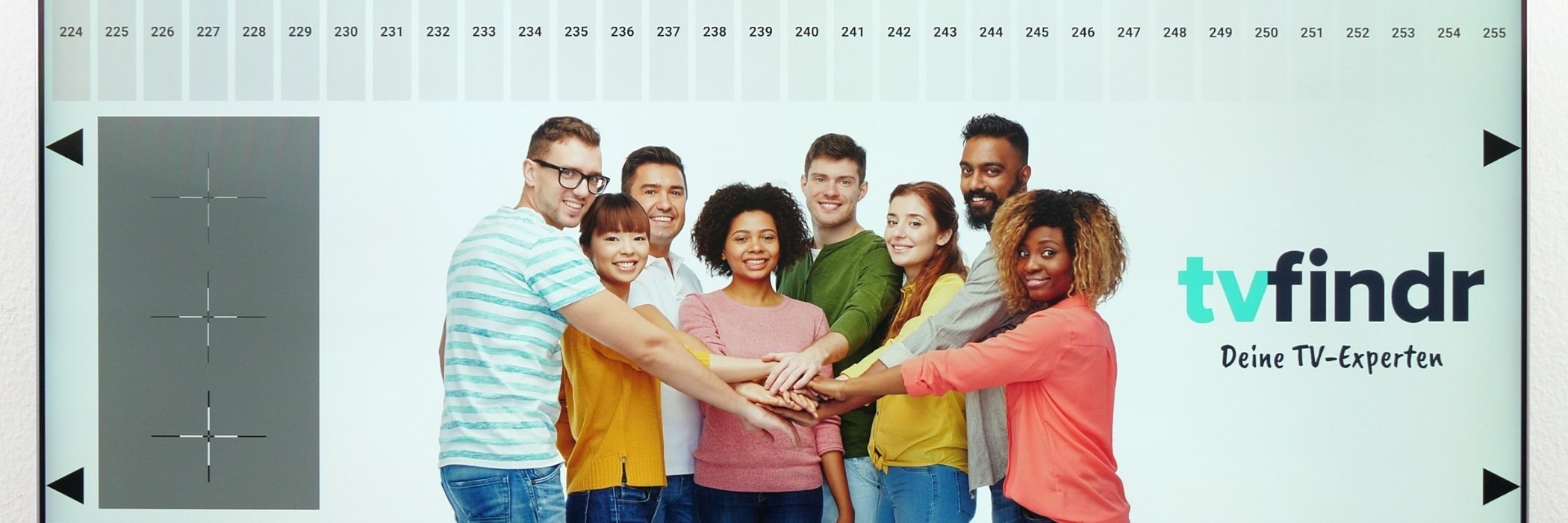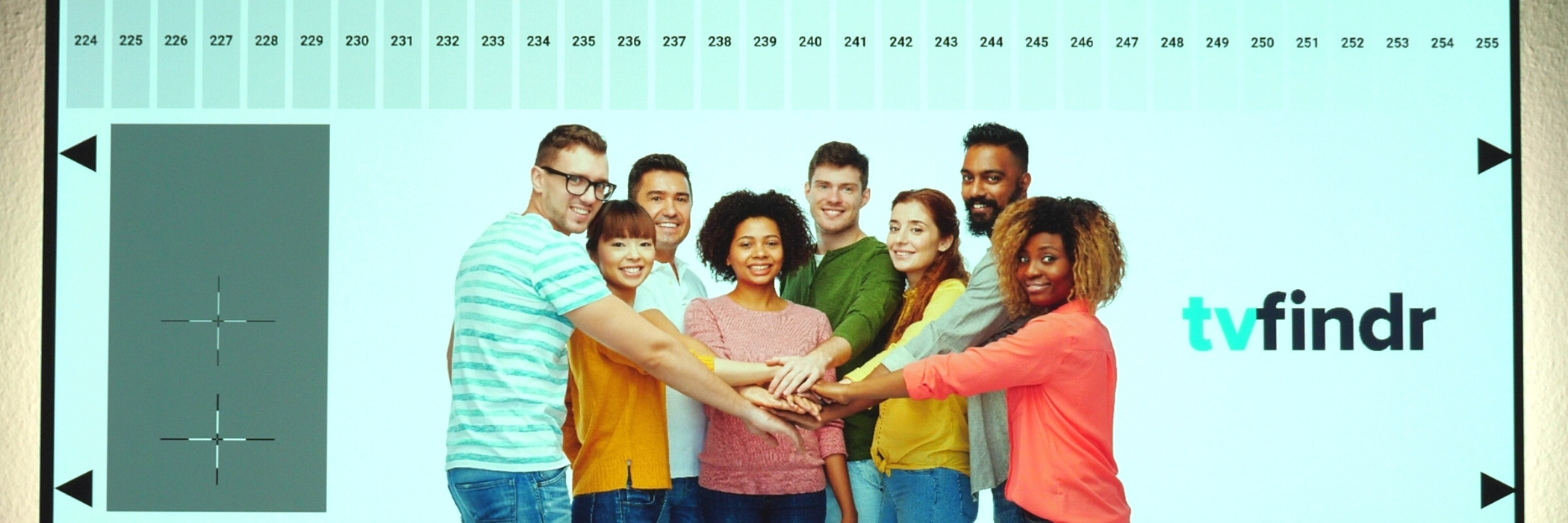The best LG picture settings – explanation & recommendation
One question at first: Is there such a thing as the most beautiful or even best LG picture settings at all, or isn’t the optical impression literally in the eye of the beholder? Yes and no. In other words: There is no general answer to this question. That’s exactly why we’ll give you an overview in this guide, which takes you step by step by the hand with the help of explanations and recommendations and ultimately leads you through the wide world of the settings of your LG TV.
Note: In this article, we will focus on the settings options of the LG OLED C19LA. Compared to the OLED CX, this model differs slightly from the current model of the C-series in terms of user interface. We also base our settings on the basis of test pictures. Only you can decide whether you like the final result or not. So if in doubt, feel free to deviate a bit and play around with the parameters. All test images shown here can be downloaded free of charge. You can then transfer the images to your TV via USB stick, Apple AirPlay or your laptop. Important: During the entire process, make sure that you calibrate your TV from a normal sitting distance.
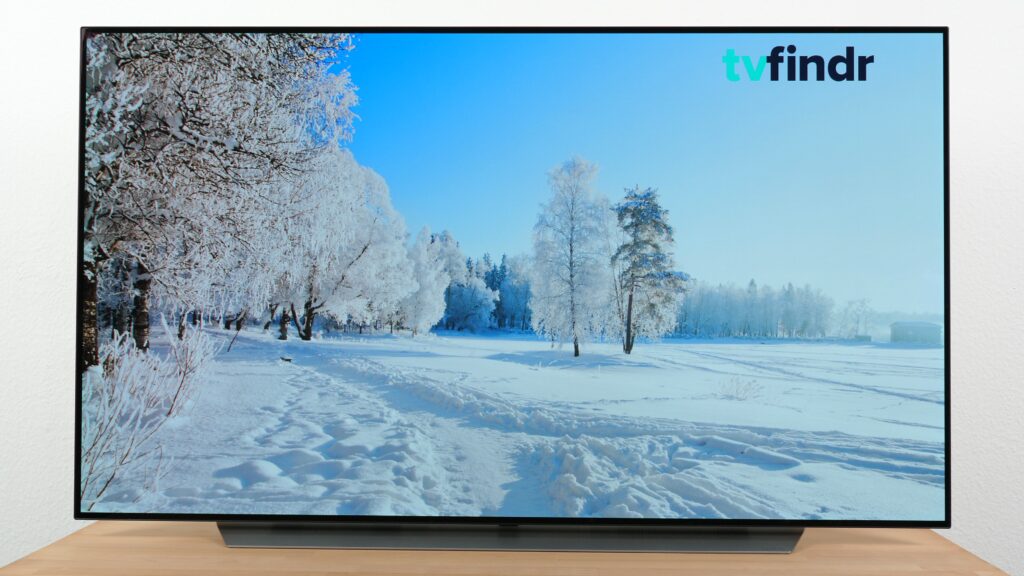
A good image depends on several factors
- The LG model you own: Depending on whether you have a high-contrast OLED panel – as we use it in this guide – or a brighter but overall lower-contrast LCD panel in your TV.
- The environment in which your TV is placed: Do you often watch during the day and in a lot of light or rather in the evening or in dark conditions?
- The way you use your LG TV: What kind of content do you want your TV to display?
- As well as the difference from device to device: Every TV is a little different.
- The picture quality variation with regard to the viewing angle: Do you look straight ahead at your TV or do you sit at an angle to the panel?
- Your subjective impression: Ultimately, it’s your personal taste that decides.
What picture settings does LG provide?
The WEB OS operating system in version 6.0 of our review sample provides several so-called picture modes with predefined display settings. You can further customize these presets to adjust the picture to your taste for different content, such as sports or movies, and thus make your LG picture settings even better.
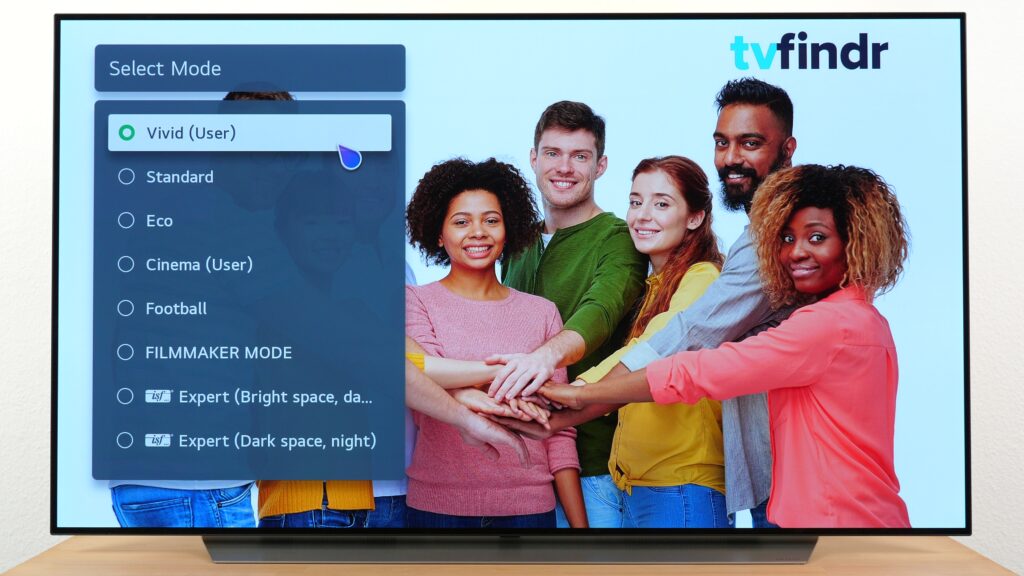
Vivid
Here, the TV outputs an exaggerated and sharper picture with increased brightness and contrast values. Overall, the display is quite loud. If you are one of those who like to look at strong colors, this is the mode of your choice.
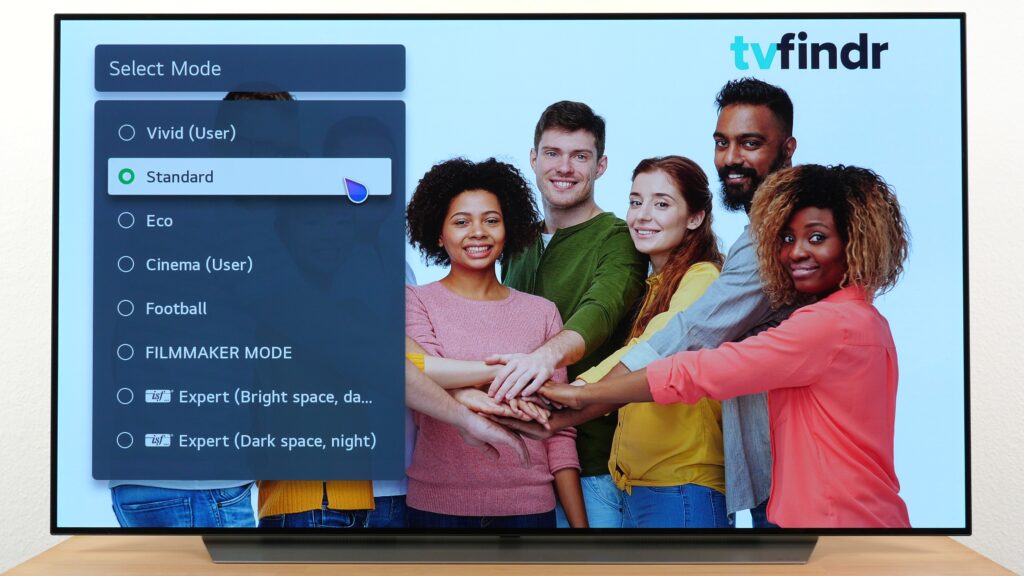
Standard
An adjustment-free setting of the TV picture. All values are set to the default settings that come with the LG TV from the factory.

Eco
If you are more of an energy-saver, the power-saving mode is the setting of your choice. However, you will have to accept quality losses. If you want to get the most out of your LG TV, we do not recommend this mode.
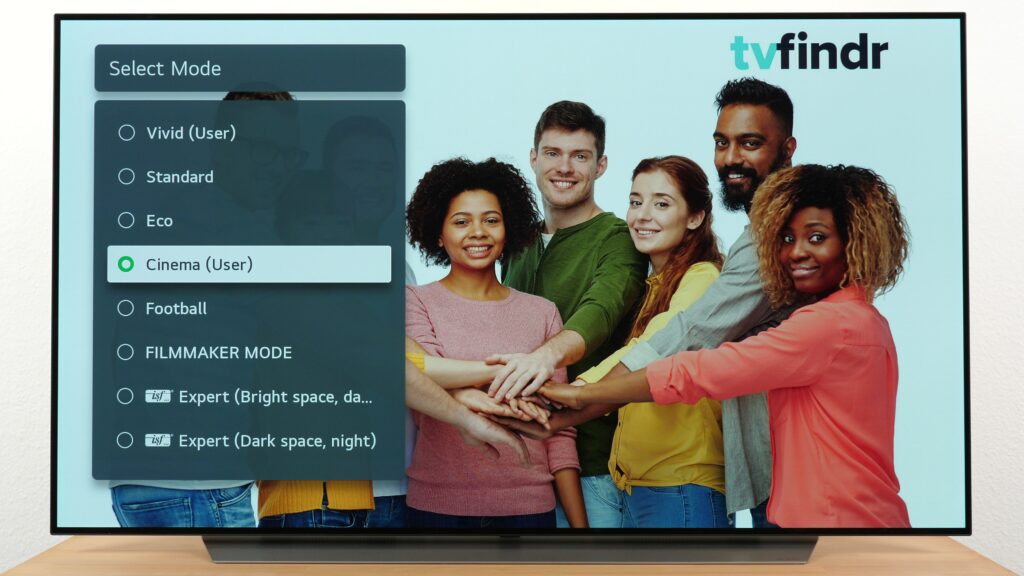
Cinema
Your TV tries to create the best possible picture for your cinema experience. It is best to use this mode in the evening or when there is little light in the room to improve your LG picture settings.
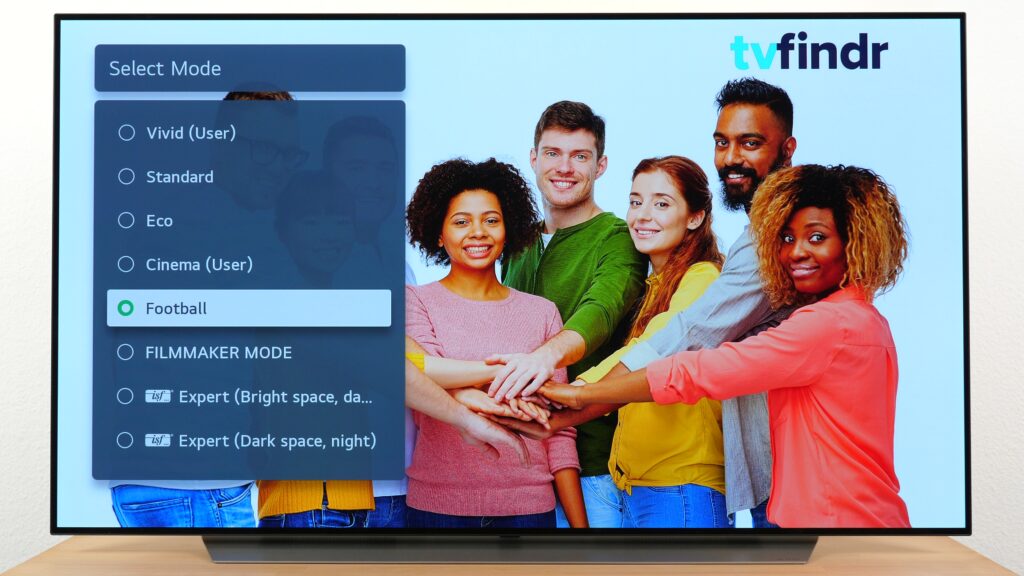
Football
This setting variant aims to display fast movements sharply. Perfect for watching your favorite sports.
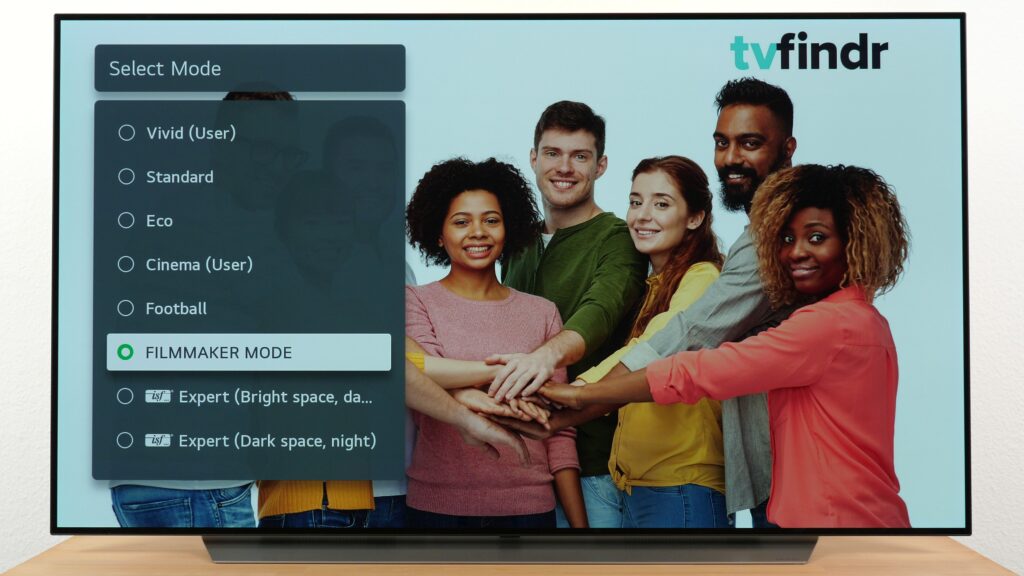
FILMMAKER-Mode
If you select this feature, your TV will adjust itself according to the director’s predefined values. For example, color, aspect ratio or frame rate. The idea is to output the picture as close as possible to the way it was captured by the film cameras.
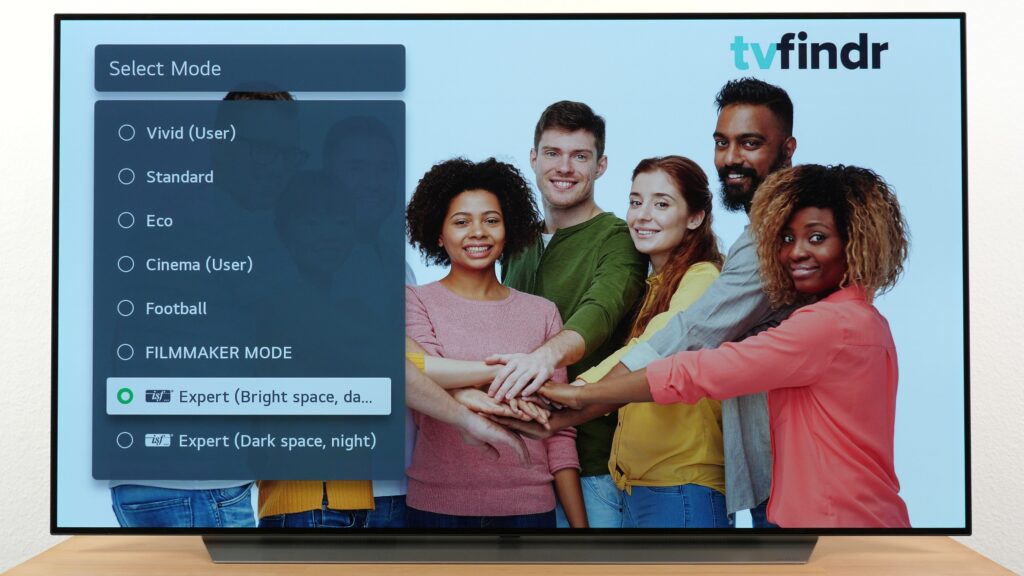
isf-Expert
In contrast to the other picture modes, this picture mode enables a completely independent adjustment of the TV picture, whereby the brightness of the surroundings plays a major role. A bright or dark variant is available for selection.
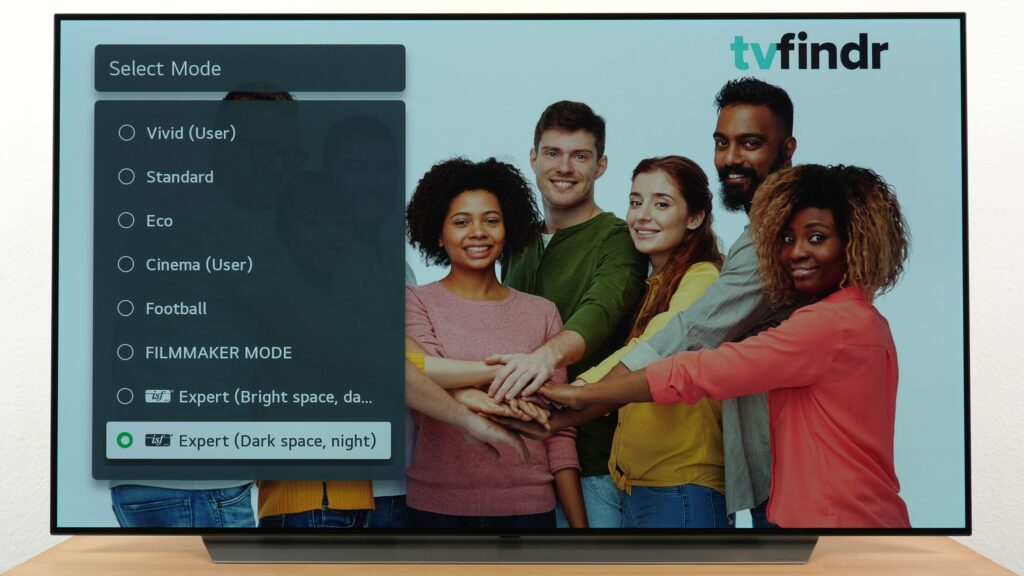
The name of this setting mode is not without reason and is intended for certified isf experts only.
The isf expert not only compares different test images with setting values, but also uses professional measurement technology and calibrates various values such as the gamut or the brightness gradations in the LG picture settings of your TV.
As proof of a performed calibration, you will receive a certificate with the model name and serial number of your TV. The certificate also shows the exact parameters that the expert set.
Further display optimizations of your LG TV
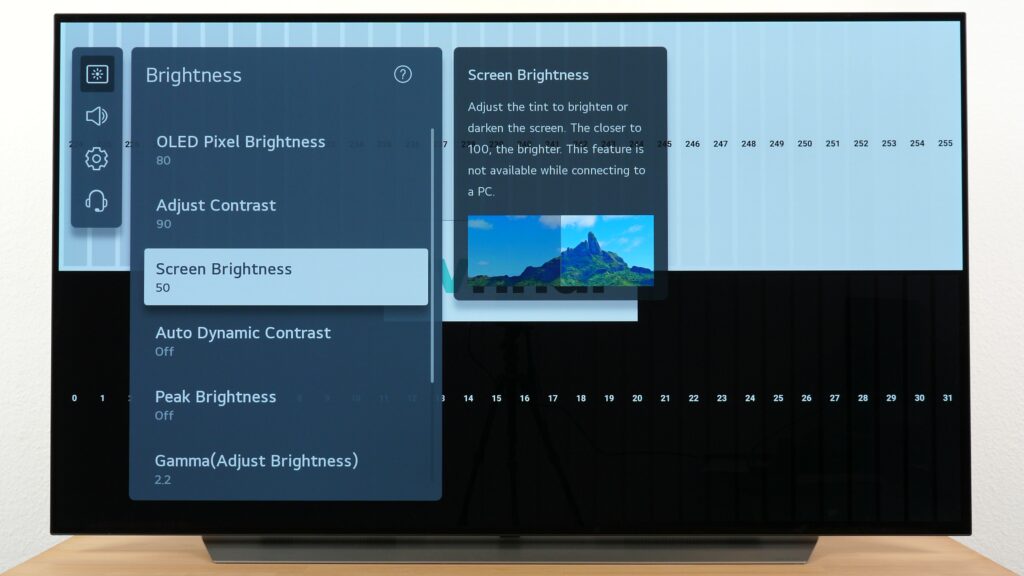
Screen Brightness
The screen brightness controls the basic brightness of your LG TV.
Depending on the ambient brightness, you should adjust the overall brightness in your LG picture settings.
The brighter your setup, the brighter the image setting should be in this field.
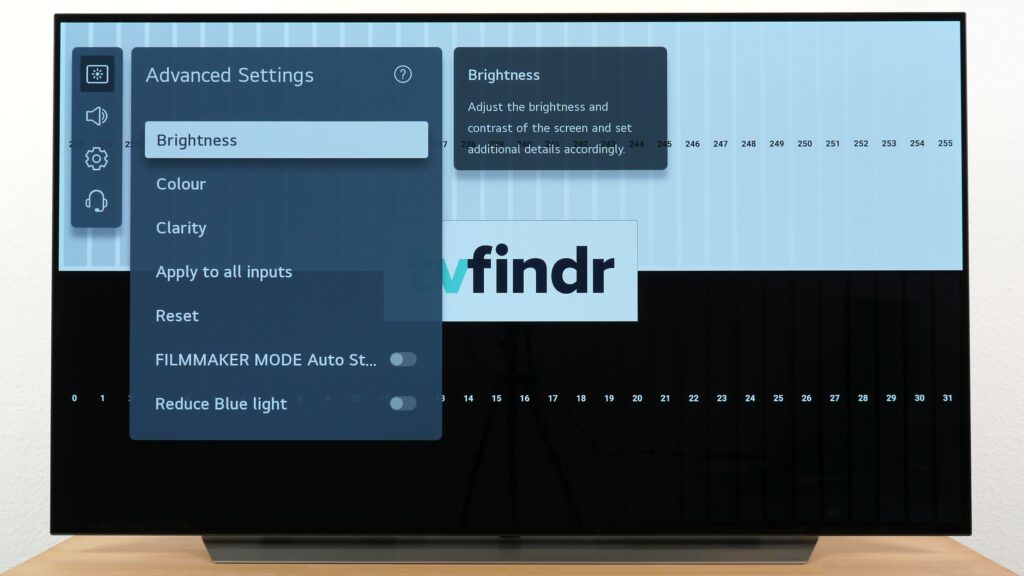
Brightness
Brightness, along with contrast, is one of the most important factors for a good image and is easily explained.
The more you increase the value, the brighter dark areas will look and you will be able to see more details on your TV screen.
If the image is displayed too dark, we also speak of a black crush. Basically, this effect is the counterpart to so-called “clipping”, in which image content is clearly displayed too brightly and details are lost at these points.
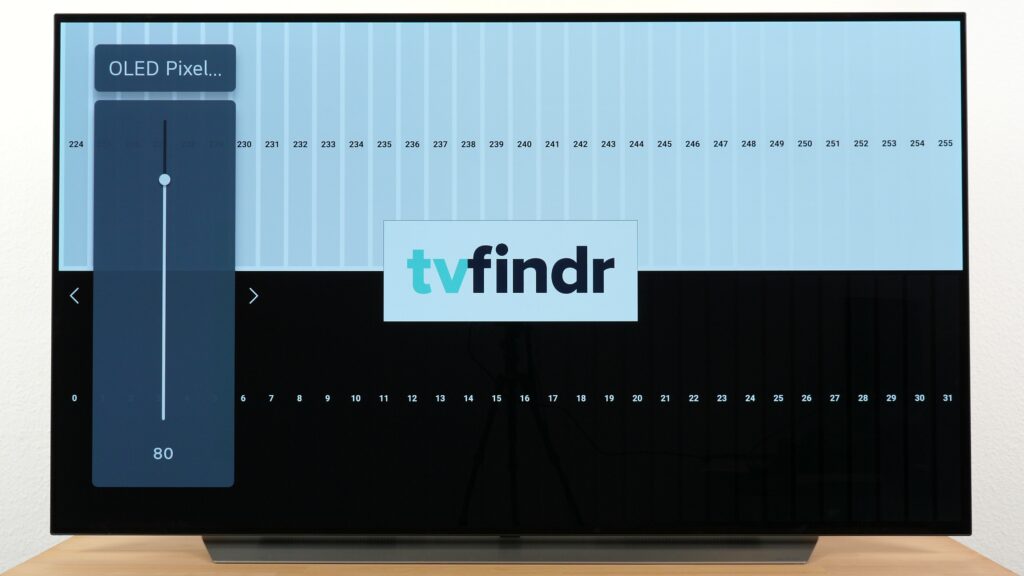
OLED Pixel Brightness
In the eponymous menu, you can regulate how much the white pixel between the red, blue and green pixels of your panel should be controlled in order to support the overall brightness of the TV.
Is the value set too high, it can negatively affect the color saturation and make the image display look pale in your LG picture settings.
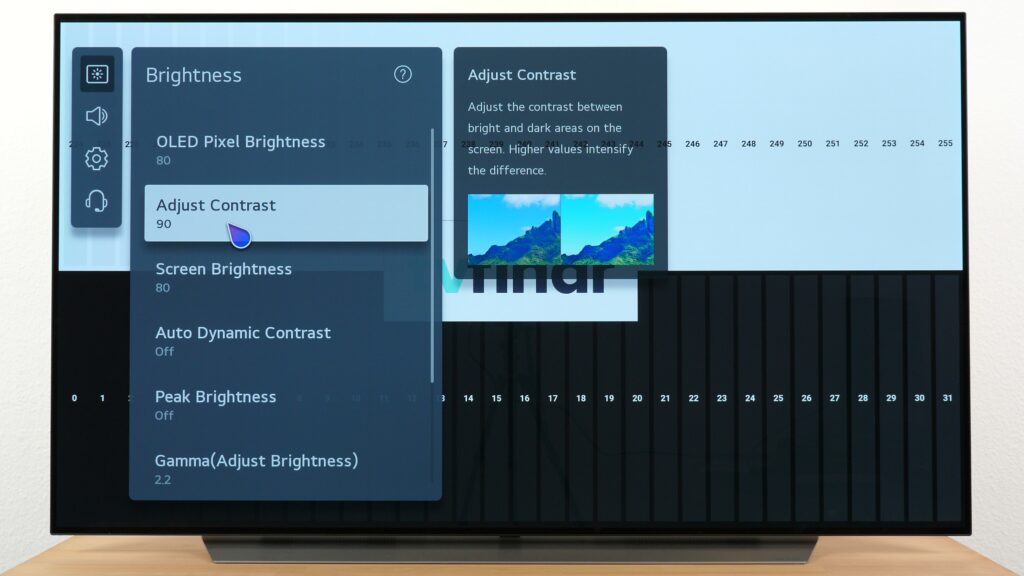
Contrast
Probably one of the most well-known parameters is definitely the contrast and the distinction from brightness when it comes to the picture settings of your LG TV.
Unlike the previous one, the contrast setting defines values between the brightest and darkest areas of your TV.
For example, foreground image elements stand out better against the background. Excessively high settings in this area cause the famous “clipping effect” in which bright areas are overexposed.
Colour Depth
The color depth helps you to control the saturation of the individual colors in your LG picture settings. If you prefer strong colors, you can adjust the image according to your preferences here.
Tint
The effect is even stronger with the color tone. This is because it can color your overall image greenish, reddish or bluish. In other words: You can use it to get an artificial image cast.
Colour Gamut
The color gamut is used to set the color scale. Depending on the source material or signal, more colors can be displayed and the color reproduction or color fidelity can be improved.
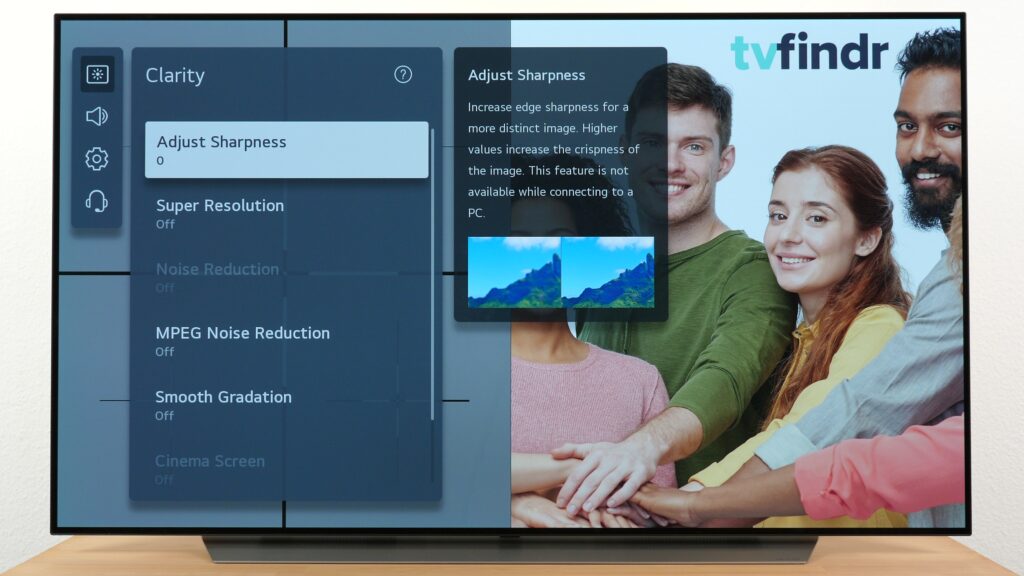
Clarity
LG’s picture settings for the so-called clarity were still simply called sharpness in earlier models. You can use it to display edge gradients more clearly in order to better emphasize smaller details. However, make sure that your image does not “clip” when calibrating your LG picture settings.
In the context of screen technology, this term refers to the display of overexposed areas on your TV device. The spots, also known as burnt out, are so bright that you will lose picture information in these areas if your settings are not readjusted.
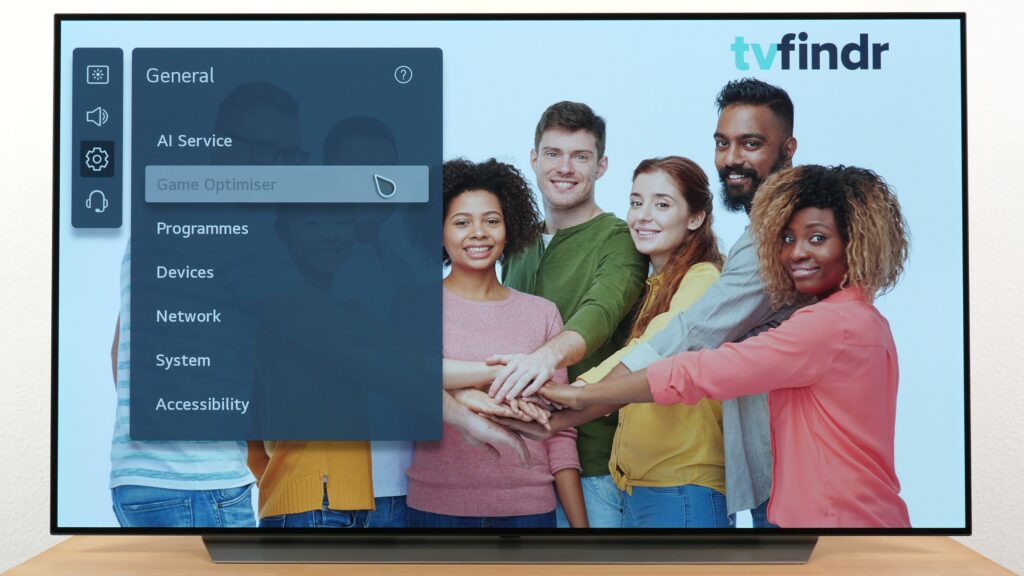
Game-Optimiser
As soon as you turn on your console, the so-called game optimiser is called into action.
In this special menu, which can be found under “General”, you can select one of three preconfigured presets – depending on the game genre. Alternatively, LG allows you to adjust the configuration of the refresh rate, the latency, the variable refresh rate or the amount of blue light in the picture according to your mood. If you do not like purple as the menu color, you can also switch to orange or green in the gaming optimiser of LG’s picture settings.
If you’re still wondering how the two stabilizers for white and black work: These two points work practically like contrast. For games that tend to be dark, you can see more detail in black corners when you turn up the black stabilizer. The reverse is also true for the white stabilizer and game titles that tend to be too bright for you.
HDR effect (on CX model)
With the help of this mode, a dynamic image is created by expanding the bright and dark areas afterwards. Basically, this setting tries to artificially imitate the HDR quality. Depending on the content, this can make the overall image look unnatural and out of place.
Advanced Settings
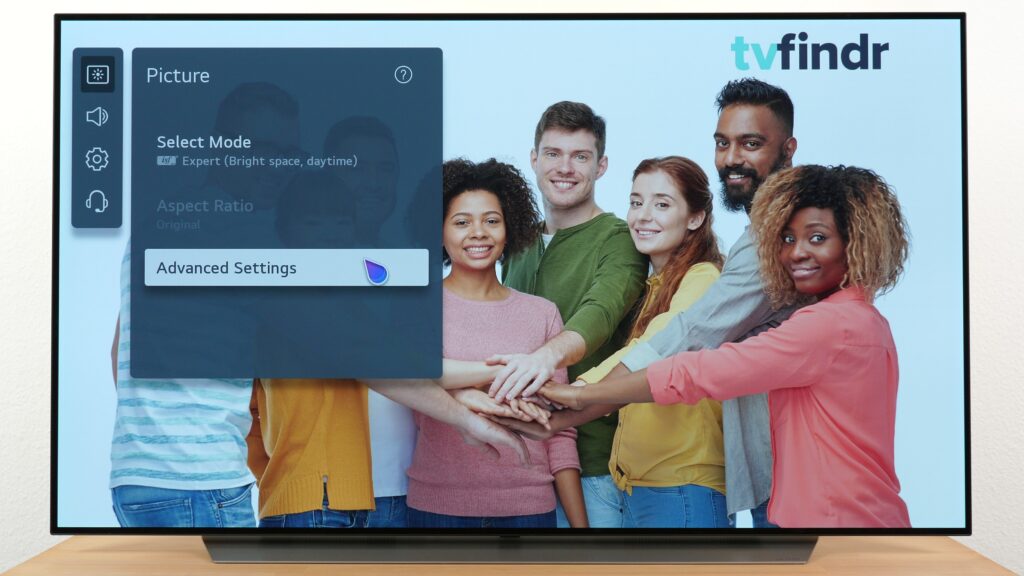
Dynamic Contrast
The dynamic contrast setting is basically the artificial adjustment of the so-called Electro Optical Transfer Function curve, or EOTF for short. Result: A greater HDR effect is created compared to the conventional TV picture.
Dynamic Tone Mapping
This expert setting controls the contrast reproduction when HDR content is played. Simply explained, Tone Mapping is a kind of brightness compression that your LG TV does for you. In practice, this is how it works: If the image content has been mastered for up to 10,000 nits, for example, Tone Mapping adjusts this brightness range down until it can be displayed by your LG TV – which is “only” about 760 nits bright, for example.
Super Resolution
At lower resolutions, the function calculates “missing” pixels from the existing image information and, on this basis, makes the image available with more pixels than the source material actually provides. For example, the software can display an image that is intended for a resolution of 1080p in an artificially generated 4K or UHD resolution.
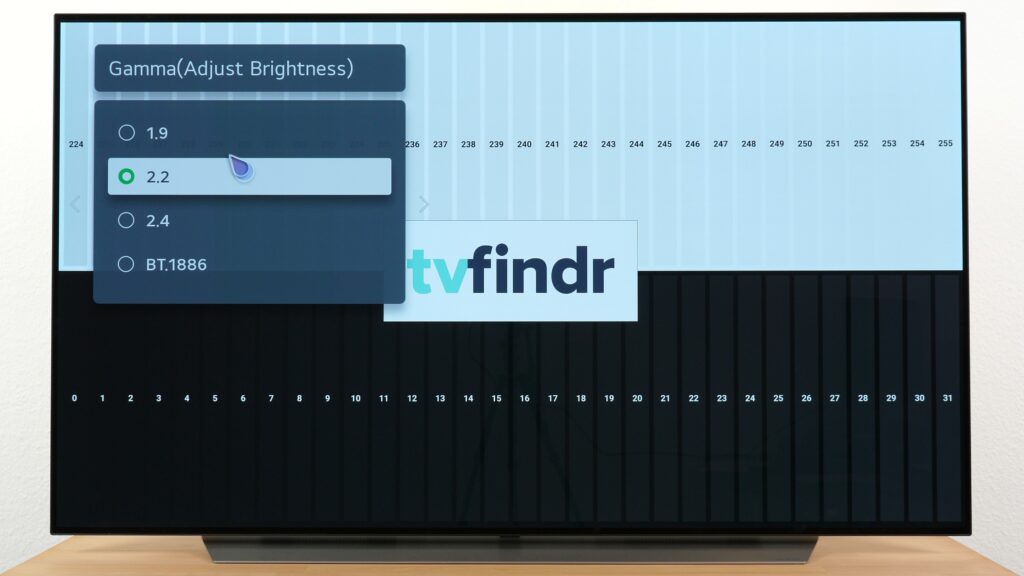
Gamma
You can use the gamma value to adjust the brightness levels via your LG picture settings. More precisely, you can use it to regulate the brightness of your screen via a total of four different presets.
These are the two extreme values 1.9 and 2.4, the middle with a value of 2.2 and the standardization BT.1886, which is valid since 2011. These values can play a role in film and series and falsify the source material.
Basically, you can remember that releases from 2011 onwards have the gamma standard BT.1886, while earlier productions usually use gamma 2.2. For example, applying a gamma value of 2.2 to a source material with gamma 2.4 or BT.1886 can result in paler colors. Except for the THX format, which uses gamma 2.4, you can’t ultimately tell which material was mastered with which gamma values.
White balance
This item in your LG picture settings refers directly to the color temperature of white or brightly displayed areas. You can choose from cold and a correspondingly higher blue light content to warm and a more yellowish display on your LG TV.
Image options
Noise reduction
With the so-called noise reduction you can remove the noise effect, which can occur depending on the transmission or the source material. This feature also takes into account the noise in MPEG formats, i.e. digital content. The result is a smoothed image and several levels are available.
Black level
The black level assists you in changing the darkness of the screen. In this way, you can adjust the contrast and brightness of your LG TV.
Auto brightness
Automatically adjusts the screen brightness to movements in the video. Beware that this setting is a power-saving function and can cause your image to be output with less brilliance.
TruMotion
The TruMotion option in your LG picture settings makes an intermediate picture calculation of the shown content and is significantly responsible for the motion handling of your LG TV. The function ensures that scenes look smoother in your LG picture settings. For content with 24 frames per second, this function helps you and corrects the different display intervals of images, which can lead to the so-called judder effect.
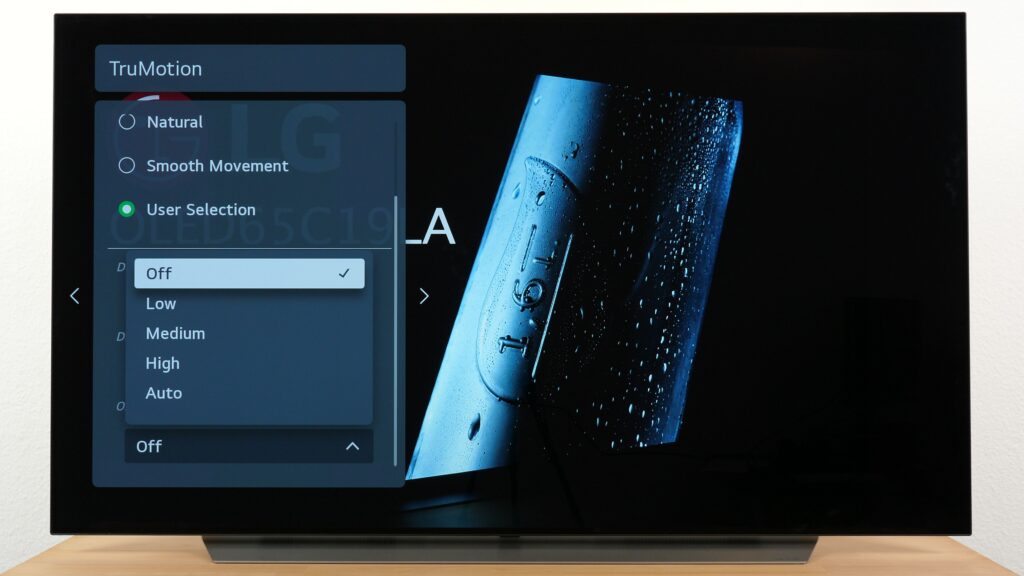
On the other hand, this can make the visual impression too smooth for you, since this feature takes a lot of scenes’ dynamics out of the content. In short: Action scenes, for example, tend to look rather feeble to the viewer. For many, the so-called cinema judder is simply a part of the action.
You can choose between the following options:
- Off: Your LG TV does not use the function at all.
- Cinematic Movement: Adjusts the wobble of the motion on the screen to give a cinematic feel.
- Natural: Adjusts images with lots of motion to look natural and clear.
- Smooth Movement: Makes the image reproduction of fast camera pans on your TV smoother.
- User Selection: This setting allows you to fine-tune the picture yourself.
OLED Motion Pro
This LG feature – also known as Black Frame Insertion – reduces motion blur based on black frames that are dynamically inserted during a scene and provides a smoother and clearer viewing experience. Depending on how sensitive your eyesight is, you may notice more or less flickering when viewing appropriately processed scenes. You can find this setting in the TruMotion menu.
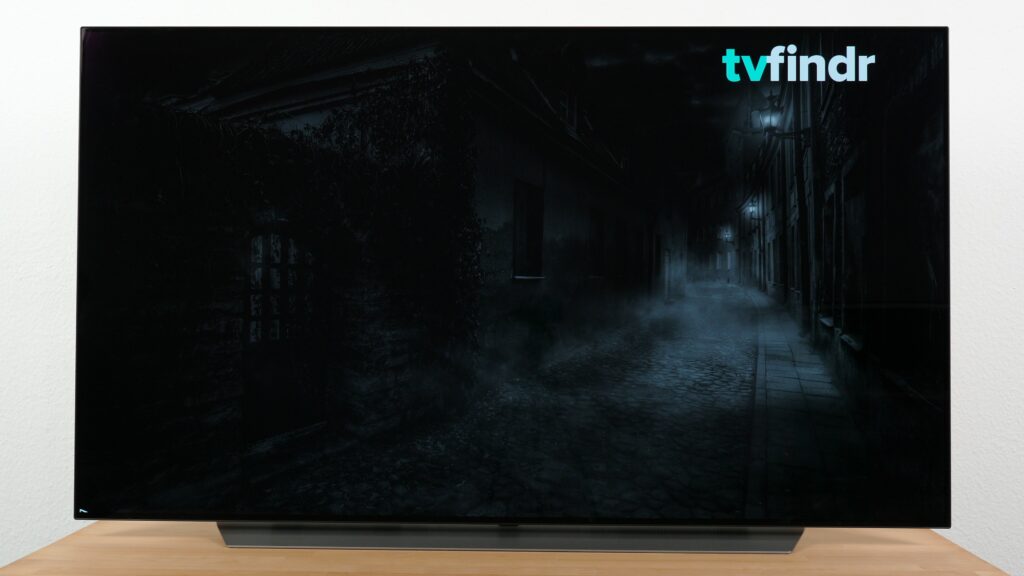
These are the best LG picture settings
So! Now enough of all the technical terminology and on to the practical part – namely setting up your LG TV. We’ll take you through the A-Z of the settings chronicle and give you all sorts of recommendations for the respective parameters in the further course.
Remember: In case of doubt, you still decide about the picture. Feel free to vary one or the other value in your LG picture settings if you don’t like the final result. As already mentioned, image settings are a subjective feeling of each individual. Everyone has a different idea of their own “perfect” image.
Attention: A single, short confirmation of the settings button brings you to the simplified view of the settings menu. At this point, you can only switch through your predefined presets. This has nothing to do with the actual TV settings at first. Of course, we use the advanced picture mode for this. To get there, simply press the gear wheel a bit longer and you’re ready to go.
How to adjust the LG picture settings of your LG TV as precisely as possible
First, search the settings menu for all functions that should be disabled. If you have difficulties with the meaning of individual functions, take a look at our two sections above on the different image modes and other settings.
Furthermore, make sure that the energy-saving mode is actually turned off before you start your calibration. You can find this entry in the support menu called “OLED care and self-care”. We also recommend turning off the so-called AI modes in the settings menu and the dynamic contrast in the brightness settings.
If you want to reactivate these functions later, you can do so without any problems. If you are sure that all these functions are disabled, you can finally start with the actual adjustment of your TV picture.
Where do I start configuring my LG image settings?
To get a first overview, you can switch to the settings for the picture mode and take a closer look at the different presets. We’ve already covered what the individual modes do above. If you are unsure, you can return to the Image Settings section.
For normal use, we recommend starting with one of the two isf Expert presets. These are already set relatively precisely out of the box. Depending on how bright your environment usually is – illuminated or whether you mainly use the TV in a rather bright or darker setup – you select the respective preset.
Directly use the expert setting of your LG TV
We use studio lights and therefore have a correspondingly bright room. Our choice therefore falls on “bright areas”. The designation for older OLED TVs can also be “light or dark room”. Don’t be put off by an initial slight yellow tint that you see afterwards. This happens as soon as you switch from a picture setting with a comparatively high blue content and quickly subsides. Our subsequent settings will reduce this effect even further.

From there, you can access the advanced settings of your LG TV. More precisely, the brightness and the brightness of the OLED pixels of your TV panel. You don’t necessarily have to set this value to the maximum. You can set the slider to a value between 70 and 80 at most – this level is completely sufficient.
Note: If you are wondering whether the brightness value also has a direct influence on the brilliance of HDR content, we can clearly answer this question with a “yes”. If you now think: The presentation of such content will be worse! Don’t worry, as soon as your LG TV detects HDR content, it automatically adjusts the brightness back to a value of 100.
Enhancement via contrast & brightness
Once you have finished adjusting the OLED PIXEL brightness, you can navigate directly to the contrast adjustment to improve the image quality via your LG picture settings. At this point, we recommend choosing a range between 250 and 251 on our test picture on the right. In short: If you can no longer see the contours of the gradations around the value 251 on your screen, the contrast is already too high. This in turn poses the risk of so-called clipping – burned-out areas without image information.
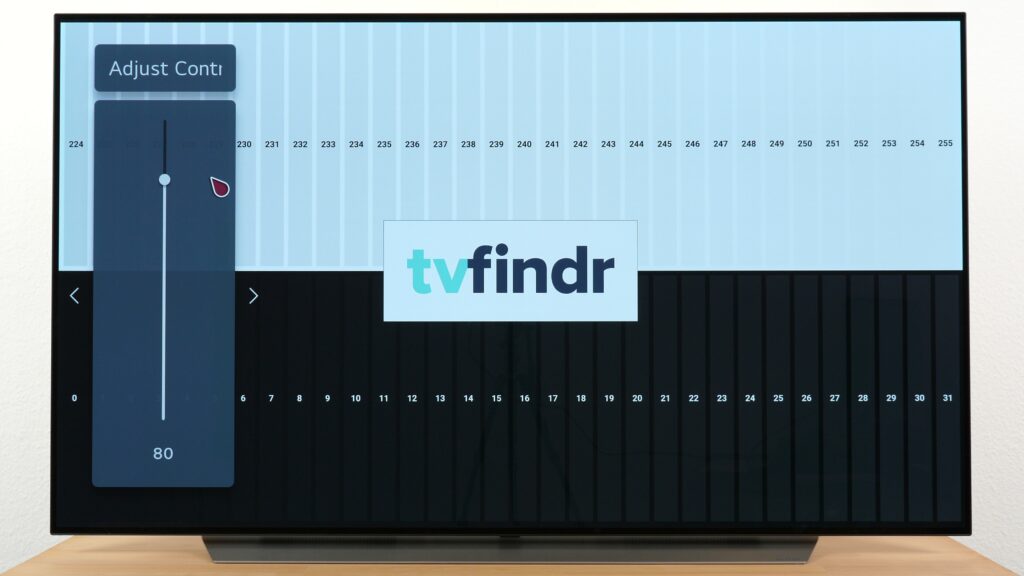
The contrast is directly followed by the screen brightness. At this point, our recommendation is to leave the value at 50 points if possible. If you use higher values, the picture can look washed out. Significantly lower values quickly make the image look underexposed.
Attention: Do not confuse the menu item Screen Brightness with the brightness of the OLED pixels. The former increases brightness and color space in your LG picture settings.
What about the color scheme?
Now we have arrived at the color settings options, more precisely at the Color menu item. Often you don’t have to do very much in this section. Just make sure to perform the white balance at the bottom beforehand. As soon as you change the white balance after you have already made the settings for the colors, this can lead to more or less strong deviations in the color values.
Orientate yourself to a warm value of about 10 to 20 in your LG image settings. As already mentioned, you do not have to change much or even nothing in terms of color depth and hue. If you like it a bit more colorful, then add a bit of color depth to the image in your LG picture settings. What you should keep your hands off is the hue. This setting colors the image reddish or greenish, for example, and quickly creates an unnatural optical impression. Therefore, you should really choose your values carefully at this point. In the advanced settings of your LG TV, the white balance is treated in more detail in the form of grayscale.
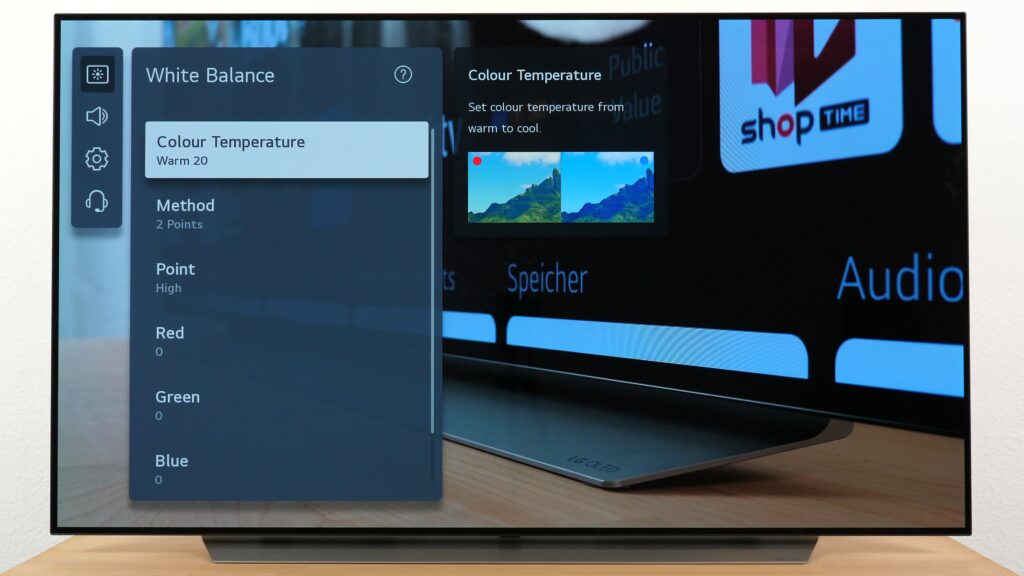
Note: At this point, the settings become so complex for a “normal consumer” that we advise you to get an isf-expert with professional calibration devices and corresponding software on board. If you do not know someone in this field, most of you don’t have to adjust anything here at this point.
How to adjust the clarity of your LG TV
To clear up any misunderstandings in advance: The term sharpness has been replaced by “clarity” in the menu of LG’s picture settings for the current models. But let’s continue: It is best to use our test picture with the four predefined crosses on the left side of the picture for this setting. Important for you: Avoid so-called double contours above the cross edges.
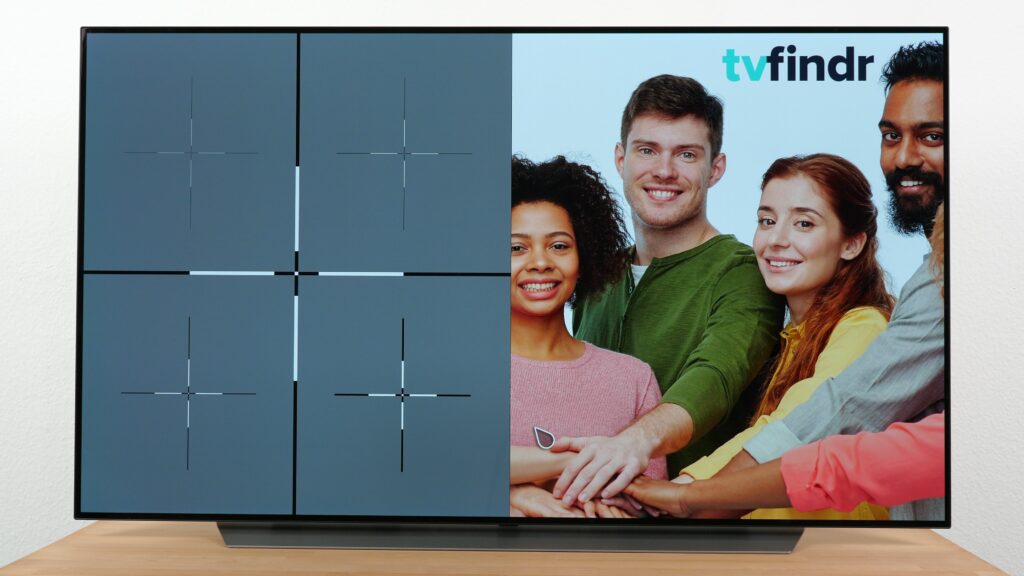
In order to give you something more natural than just straight structures, you can also use the ladies and gentlemen on the right side of the image to give your image the necessary degree of sharpness. Start at zero and work steadily forward until you can recognize the strands of hair as cleanly as possible. Here, too, pay attention to the aforementioned duplications within the outlines.
The Super Resolution, i.e. the value for the so-called upscaling feature, is really a matter of taste in our opinion. You can also try out different settings here and choose the one that suits you. Noise reduction is usually not necessary. We also do not really recommend the “Smooth gradation”.
Dynamic contrast, OLED brightness and gamma value
You should avoid the dynamic contrast in the advanced LG picture settings of your LG TV. In other words, we recommend turning this option off. This ensures a more natural picture. In the OLED pixel brightness, you can regulate how much the white pixel of your panel should be controlled to support the overall brightness of your TV. If you set this value too high, it will be at the expense of the color saturation. Normally, you can leave this option unconsidered.
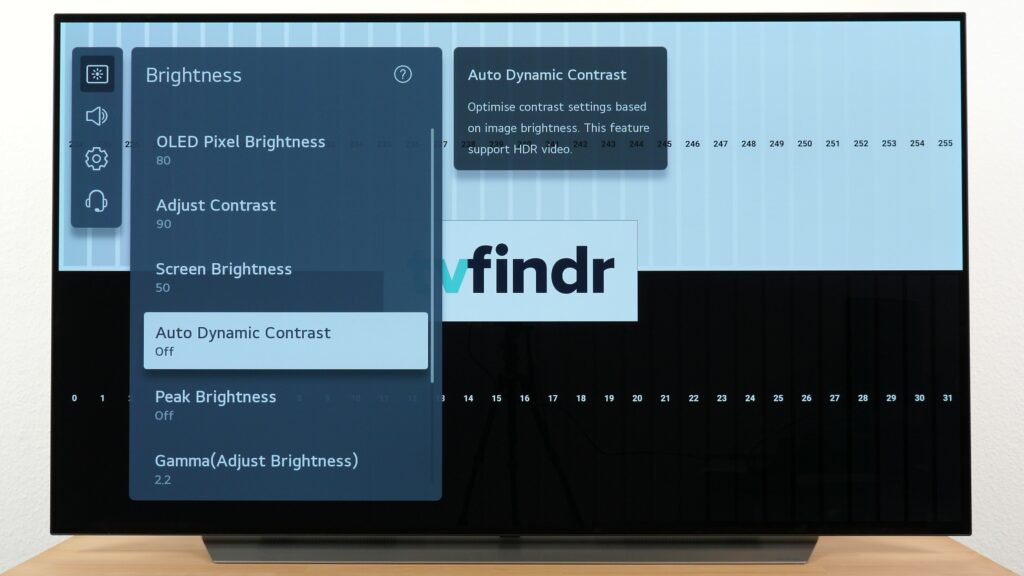
The gamma value is interesting because you can use it to adjust the center brightness of an image. The image is darker and has more depth at 2.4. You get a “flatter” image impression with a value of 1.9 in the setting. As a rule, you’ll drive with the standard setting of 2.2, but in safe waters. Our explanation of the gamma value gives you more details that you might want to know.
Further brightness and color gamut settings
You can disable the automatic brightness control and leave the black level at automatic. Both settings can be found in the “Brightness” tab. We recommend selecting the automatic option for the color space in the “Color” menu. In our experience, LG OLEDs recognize content quite reliably and adjust the color space automatically.
OLED Panel Burn-In Prevention
To make sure that your TV keeps you joy for several years, LG provides you with a “cosmetic program” in your LG picture settings that you can use. You can find the so-called OLED care under Support. Once you are there, you can deactivate the setting for screen care. Don’t worry, this does not explicitly mean the care of the OLED panel.
You will find this menu item at the very bottom. Once you have entered the OLED panel care, you can choose from several options to treat the panel of your TV more gently and to maintain it. You can switch on the movement of the display – the so-called pixel shift – with a clear conscience. In terms of logo brightness, you can either set the value to very high or low. Even the lowest setting has a big advantage in terms of burn-in prevention.
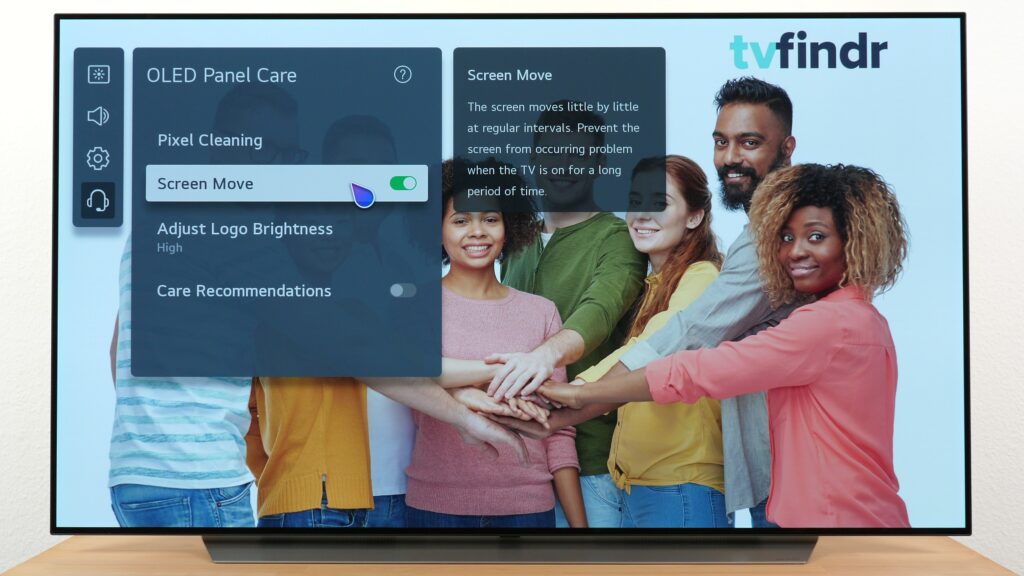
Finally, the TV shows you the so-called Pixel Cleaner or Pixel Refresher. Use this setting with caution. Normally, you should use the function for the first time after one year at the earliest. And then only if you have used the TV extensively. If, contrary to expectations, you notice signs of burn-in on your screen, you can of course use this feature earlier.
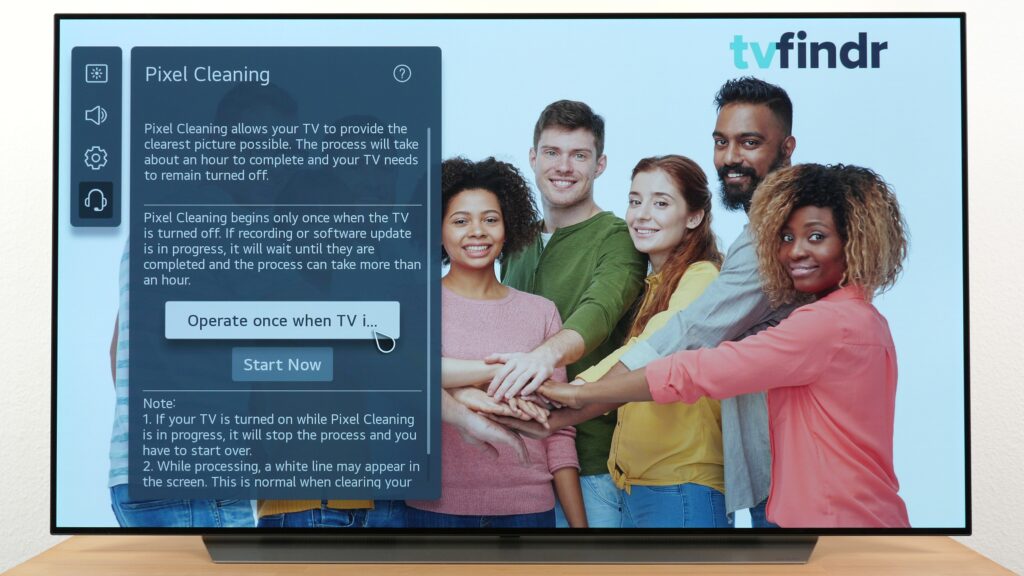
Gamers additionally use the game optimiser
The game optimizer, previously called “Mode Game”, gives you a look at all the important features you can use in connection with your gaming experience. First, make sure that your console, such as the Xbox Series X, is also connected to an HDMI 2.1 port on your TV.
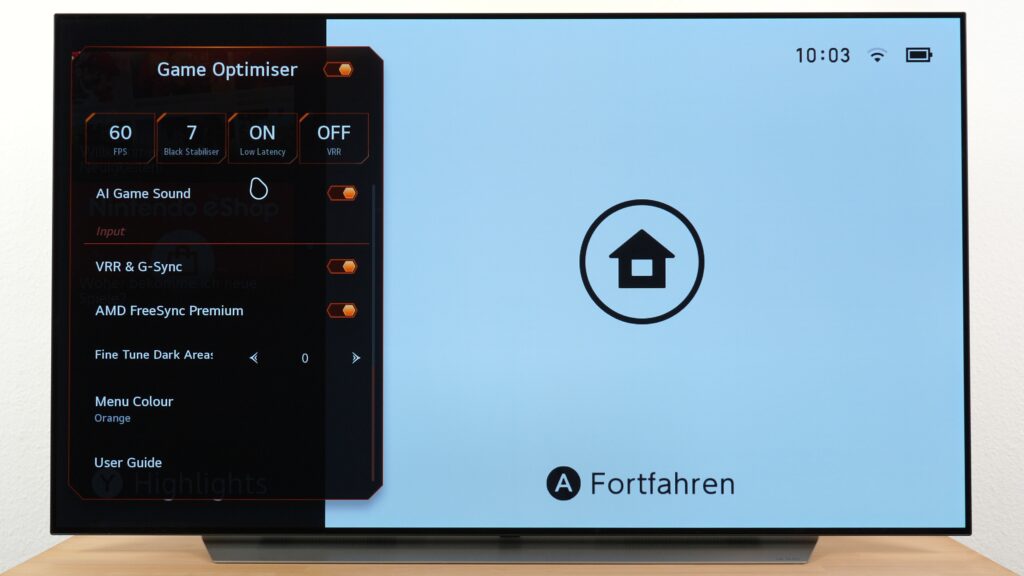
As soon as you have made sure that this connection is established, you can make use of the individual functions like the refresh rate in Hertz, the so-called Variable Refresh Rate, VRR for short, or the ALM feature for a low input delay, also called input position.
This way, you can immediately see if all features from your LG picture settings are recognized correctly by the console. Make sure that you have configured the corresponding settings – for example, HDR or Dolby Vision Gaming – on your console to really get the maximum possible display quality.
FAQ – Frequently asked questions about LG picture settings
How do you change the picture settings of your LG TV?
The image settings can be found under Settings -> All Settings -> Picture -> Select Mode. There you can either select one of the preconfigured picture modes or adjust the settings individually.
Which picture mode is best for LG TVs?
To be as close as possible to the visual image of movie and television studios, we recommend the “Filmmaker mode”. Also known as “Cinema” in older models. This option ensures the most authentic picture quality.
What is Super Resolution from LG?
Noise and artifacts during compression are minimized by Super Resolution in real time. To do this, the function analyzes the overall noise and image sharpness and performs color and detail measurements.
What are the advantages of AI picture from LG?
The so-called AI picture feature is an artificial picture enhancement and can be found in numerous LG TVs. We recommend not using this feature for reasons of a more authentic display quality.
What does the LG Pixel Refresher do?
The Pixel Refresher periodically recalibrates the pixels of OLED TVs in standby mode after a few hours of operation. This process prevents image burn-in in the long run. Modern OLED TVs should therefore not be completely disconnected from the power supply.



